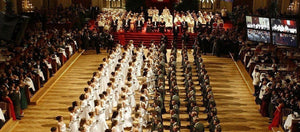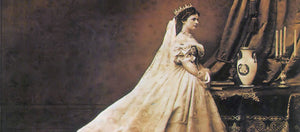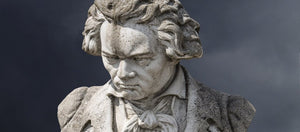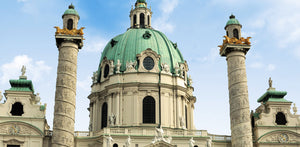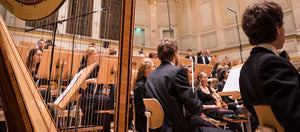Johann Strauss — The History of the Waltz King

Johann Strauss (sometimes known as Johann Strauss II or Johann Strauss, the younger) was an incredibly successful composer best known for his operettas and Viennese waltzes which earned him the title “The Waltz King”. He was born on October 25th, 1825 in St Ulrich close to Vienna and over his lifetime composed more than 500 waltzes, quadrilles, polkas and other types of classical dance music, as well as a single ballet.

August Eisenmenger [Public domain]
Lack of support
Although Johann Strauss I was a composer, he wished his son not to follow in his footsteps and go down a musical path, instead helping him find work as a bank clerk. However, undeterred by his father’s wishes, Johann Strauss II studied the violin in secret with the help of his father’s first violinist, Franz Amon.
When his father abandoned the family for his mistress, Johann was able to fully concentrate on his career as a composer. But due to his father’s strong influence over local entertainment establishments, Johann struggled to find anywhere that would let his perform. Eventually, he was able to persuade Dommayer’s Casino in Hietzing, Vienna to give him a slot, where he debuted in October 1844 when he was just 19. This infuriated his father so much he refused to ever play there again, despite being the location of many of his previous triumphs.
Dommayer’s Casino is where Johann first performed works such as the polka "Herzenslust", Op. 3 and the waltzes "Sinngedichte", Op. 1 and "Gunstwerber", Op. 4, all of which received unanimous praise from the press and musical critics. A critic for “Der Wanderer” stated, “Strauss’s name will be worthily continued in his son; children and children’s children can look forward to the future, and three-quarter time will find a strong footing in him.”
Performing internationally
Although he initially found great success, Strauss still struggled through his early days as a composer, but began winning over audiences by taking commissions to perform outside Vienna. The first major accolade he received was the honorary position of “Kapellmeister of the 2nd Vienna Citizen's Regiment”, which had previously been left vacant for two years, following the death of Joseph Lanner.
In 1848, Vienna was wracked by the revolution which saw the bitter rivalry between father and son grow much stronger. Strauss II sided with the revolutionaries, a choice that negatively affected his career, as it caused the Austrian royalty to twice deny him the coveted 'KK Hofballmusikdirektor' position, which they had planned to give to Strauss I in recognition of his contribution to music. Strauss II was also arrested by Viennese authorities for playing La Marseillaise in public, but was acquitted shortly after. Strauss I remained loyal to the royal family and composed one of his most well-known pieces, "Radetzky March", Op. 228 which was dedicated to the Habsburg field marshal, Joseph Radetzky von Radetz.

Death of Johann Strauss I
When his father died in 1849 in Vienna from scarlet fever, Johann combined his orchestra with his father’s and continued touring. A few years later, he composed several patriotic marches, including the "Kaiser Franz-Josef Marsch", Op. 67 and the "Kaiser Franz Josef Rettungs Jubel-Marsch", Op. 126, which he dedicated to the Habsburg Emperor Franz Josef I. Looking back, it’s likely he did so to win over the favour of the new monarch who ascended to the Austrian throne following the revolution.
Eventually, Strauss II achieved much greater fame than his father and became one of the most popular waltz composers of his time, touring extensively throughout Austria, Poland and Germany, accompanied by his orchestra. He applied for the “KK Hofballmusikdirektor” position several times, although he was continuously rejected because of his brushes with the law before he was finally granted it in 1863.
Stressful times
Because of incessant physical and mental demands, Johann suffered a nervous breakdown in 1853. That summer, he escaped to the countryside for a seven-week holiday, following the advice of concerned doctors. At this time, Johann’s brother, Josef, was persuaded by the rest of the family to give up his career as an engineer and take over Johann’s orchestra while he recovered.
Two years later in 1855, Johann accepted commissions from the Tsarskoye-Selo Railway Company of Saint Petersburg to play for the Vauxhall Pavilion at Pavlovsk in Russia the following year. He enjoyed the position so much that he returned to Russia to play every year between 1856 and 1865.
By the 1870s, Johann and his orchestra were touring the US, where they performed at the Boston Festival, following an invitation from bandmaster Patrick Gilmore. Johann was truly the star when he performed as lead conductor in a giant concert which featured more than 1,000 performers who played his “Blue Danube” waltz, along with many other pieces.

Credit: Verlag C. Ledermann jr., Wien [Public domain]
Rivals and admirers
Despite his huge success, Johann Strauss II still had a lot of stiff competition in the form of Émile Waldteufel, who held a commanding position in Paris, and Karl Michael Ziehrer, another superb Austrian composer. Jacques Offenbach, the German operetta composer who rose to fame in Paris, also posed a great challenge to Johann in the operetta field.
However, it wasn’t all competition — a lot of prominent composers also admired Johann. Richard Wagner commented that he enjoyed the waltz “Wein, Weib und Gesang”, Op. 333, while Richard Strauss (unrelated to the Strauss family) once said when writing his Rosenkavalier waltzes, “How could I forget the laughing genius of Vienna?” in reference to Johann. The famous Johannes Brahms was also a personal friend of Johann. They were so close than Johann even dedicated his waltz, “Seid umschlungen, Millionen!”, Op. 443 to Johannes.
There’s a sweet story which appears in both Johann’s and Johannes’ biography that tells of Strauss’ wife, Adele, approaching Johannes for an interview. At the time, it was common for a composer to write a few measures of his most popular music then sigh his name. Instead, Johannes inscribed measures from Johann’s “Blue Danube” and wrote “Unfortunately NOT by Johannes Brahms.”


